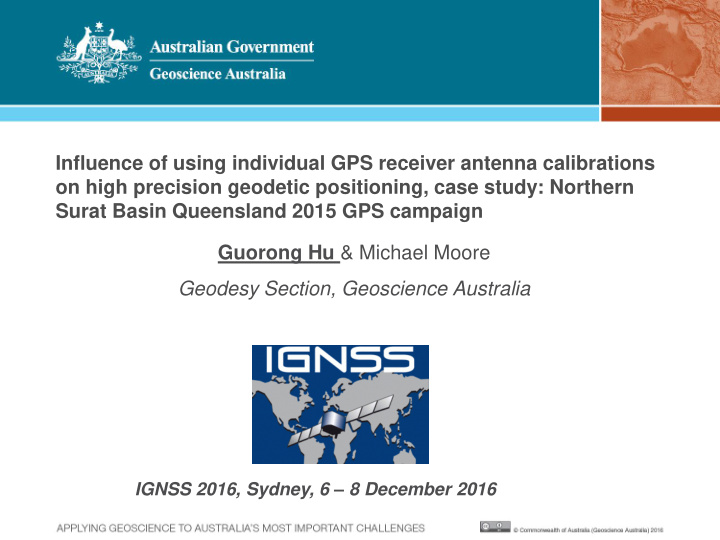



Influence of using individual GPS receiver antenna calibrations on high precision geodetic positioning, case study: Northern Surat Basin Queensland 2015 GPS campaign Guorong Hu & Michael Moore Geodesy Section, Geoscience Australia IGNSS 2016, Sydney, 6 – 8 December 2016
GNSS antenna types GNSS antenna Receiver antenna Satellite antenna Single frequency Dual frequency (mobile phone, (high precision Block II, IIA, …. Block I low cost GNSS geodetic receiver receiver antenna) antenna)
iphone GPS antenna
Basic concepts GNSS satellite Zenith antenna Mean Phase Centre GNSS receiver antenna ARP (Antenna Reference Point) PCO : Phase Centre Offset, given in NEU components relative to the ARP PCV : Phase Centre Variation, variation of the actual phase centre with the direction of the arrival of the signal , provided as a function of elevation angle and/or azimuth angle in antenna frame NRP : North Reference Point, the NRP should be properly oriented to true north for antenna calibration
Basic concepts Relative calibration : Phase centre determinations from a stationary test pier referenced to a standard (Dorne Margolin choke ring antenna, type T: AOAD/M_T ) Absolute calibration : calibration where PCO/PCV are independent of the reference antenna Individual calibration : calibration values which are specific to the antenna serial number IGS type mean calibration : calibration values for an antenna model, where several test samples are separately calibrated and averaged together by IGS antenna working group GA type mean calibration ……
History of antenna calibration of IGS products Relative antenna calibration: 30 June 1996 ~ Nov. 2006 Absolute antenna calibration: Nov. 2006 ~ present Calibration facilities officially recognized by IGS: GA, Geo++, NGS, Univ. Hannover, Univ. Bonn GA was recognized/approved by IGS antenna working group announced in IGS workshop 2016 in Sydney, Feb 2016
Why relative PCVs to absolute PCVs Systematic errors caused by assumptions of relative PCVs: PCV(AOAD/M_T)=0 & PCV(GNSS sat. antenna)=0 Advantages of absolute antenna calibration Independent from reference antenna High resolution and precision PCVs Site and location independent
Absolute GNSS antenna calibration method Two absolute calibration methods: Anechoic chamber calibration: using artificial GPS signals Robotic calibration: using real GPS signals Credit: University of Bonn GA’s robotic ACF
Why antenna calibration matter Impact on GPS solutions including: Terrestrial scale (global solutions) Station coordinates Orbit parameters Troposphere parameters
PCVs model impacts on global GNSS solutions Findings of experiment by IGS Antenna WG on reprocessed global solutions of ~ 200 stations data from 1994 to 2005: Credit: Schmid et al., 2005
Antennas calibrated at GA as of November 2016 ~ 25 different antenna types ~ 145 individual antennas > 400 individual calibrations Individual calibrated antenna PCV can be accessed at: ftp://ftp.ga.gov.au/geodesy-outgoing/gnss/products/antenna/
Case study: comparison position impact of using IGS-type mean and individual PCV models Data source: Northern Surat Basin QLD Campaign 2015 Stations: 65 Antenna types used: 4 (TRM57971.00, TRM55971.00,TPSG3_A1, and LEIAR10) Observed days: 20 days, 15-28 Sept and 13-18 Oct 2016
Antennas for Surat QLD 2015 GPS campaign TRM57971.00 NONE (L1)
Antennas for Surat QLD 2015 GPS campaign TRM57971.00 NONE (L2) Significant difference among different antennae in terms of serial numbers
Antennas for Surat QLD 2015 GPS campaign TPSG3_A1 NONE (L1)
Antennas for Surat QLD 2015 GPS campaign TPSG3_A1 NONE (L2)
Antennas for Surat QLD 2015 GPS campaign LEIAR10 NONE (L1)
Antennas for Surat QLD 2015 GPS campaign LEIAR10 NONE (L2)
Position differences between using IGS-type mean and individual PCV models
Findings from the comparison between IGS type mean and individual PCV TRM57971.00 NONE antenna better agreement with IGS type mean Maximum position difference is 20.9 mm in vertical component of site SB56, which is TPSG3_A1 NONE antenna Horizontal component position differences are within 3 mm Large position differences for vertical component but correlates with antenna type
Discussions • Should we give up IGS type mean PCV and use individual PCV models? • Suggestions: use IGS type mean PCV for IGS stations which will keep consistency with IGS products and use individual PCV as many as possible for other non-IGS stations
Questions? Phone: +61 2 6249 9884 Web: www.ga.gov.au Email: guorong.hu@ga.gov.au Address: Cnr Jerrabomberra Avenue and Hindmarsh Drive, Symonston ACT 2609 Postal Address: GPO Box 378, Canberra ACT 2601
Special Case: Damaged Antenna – ASH701945E_M__NONE (L2)
Special case: damaged antenna – ASH701945E_M__NONE (L1)
Repeatability of PCV for reference antenna TRM59800.00 NONE (L2) L2 dPCV < 2 mm
Repeatability of PCVs for reference antenna TRM59800.00 NONE (L1) L1 dPCV < 1.5 mm
Individual antennas – TRM59800.00__NONE (L1) Significant difference among different antennas in terms of serial numbers
Individual antennas – TRM59800.00__NONE (L2)
Individual antennas – TRM29659.00__NONE (L1)
Individual antennas – TRM29659.00__NONE (L2)
First ever robot calibrated antenna: ASH701945.B__NONE (L1)
First ever robot calibrated antenna: ASH701945.B__NONE (L2)
Individual antennas – TRM57971.00__NONE (L1)
Individual antennas – TRM57971.00__NONE (L2)
Satellite antenna calibration method Not all GNSS satellite antenna are luckily calibrated Estimation of satellite antenna corrections from IGS re- processing campaign using global GNSS data
Summary and conclusions GA robotic GNSS antenna calibration operational since 2014 Several antennas previously did not have robot calibrations
Overview Why we need to do antenna calibrations Antenna calibration history GA’s antenna calibration facility (ACF) Impact on estimated station position when using individual PCVs Summary and discussions
Credit: www.ngs.noaa.gov
Recommend
More recommend